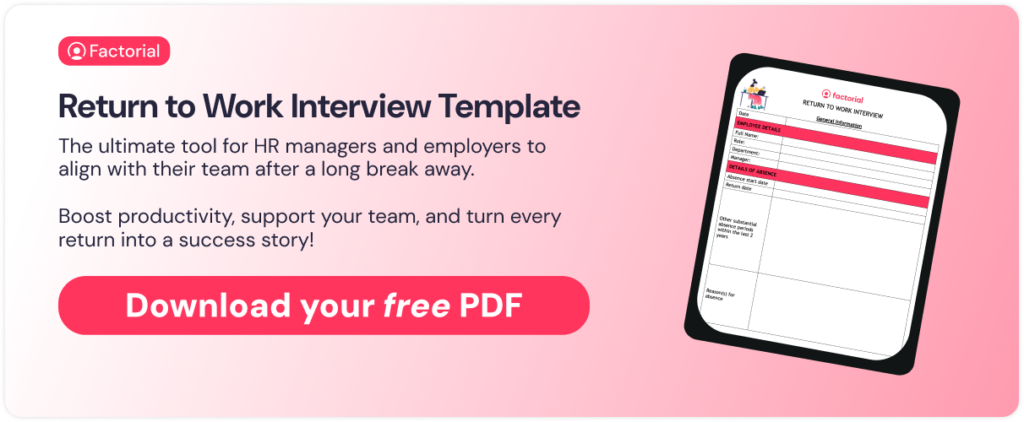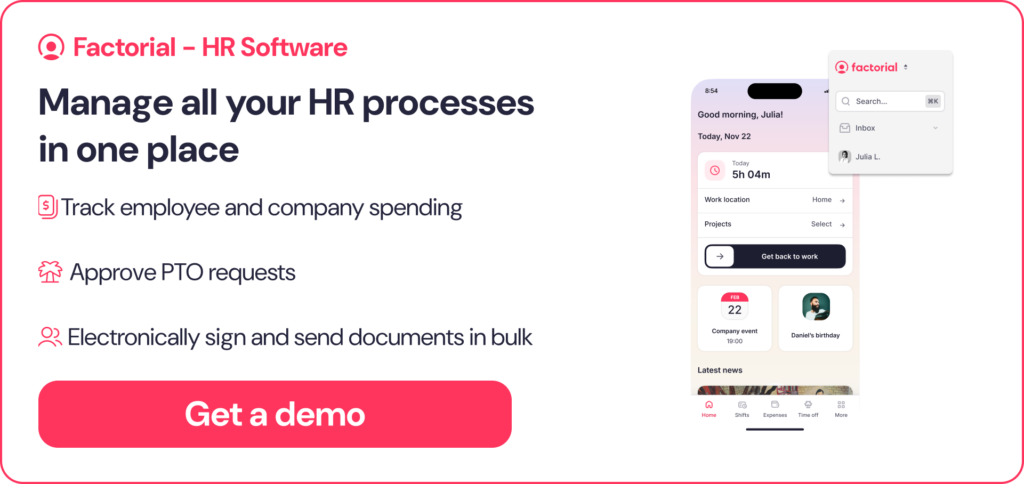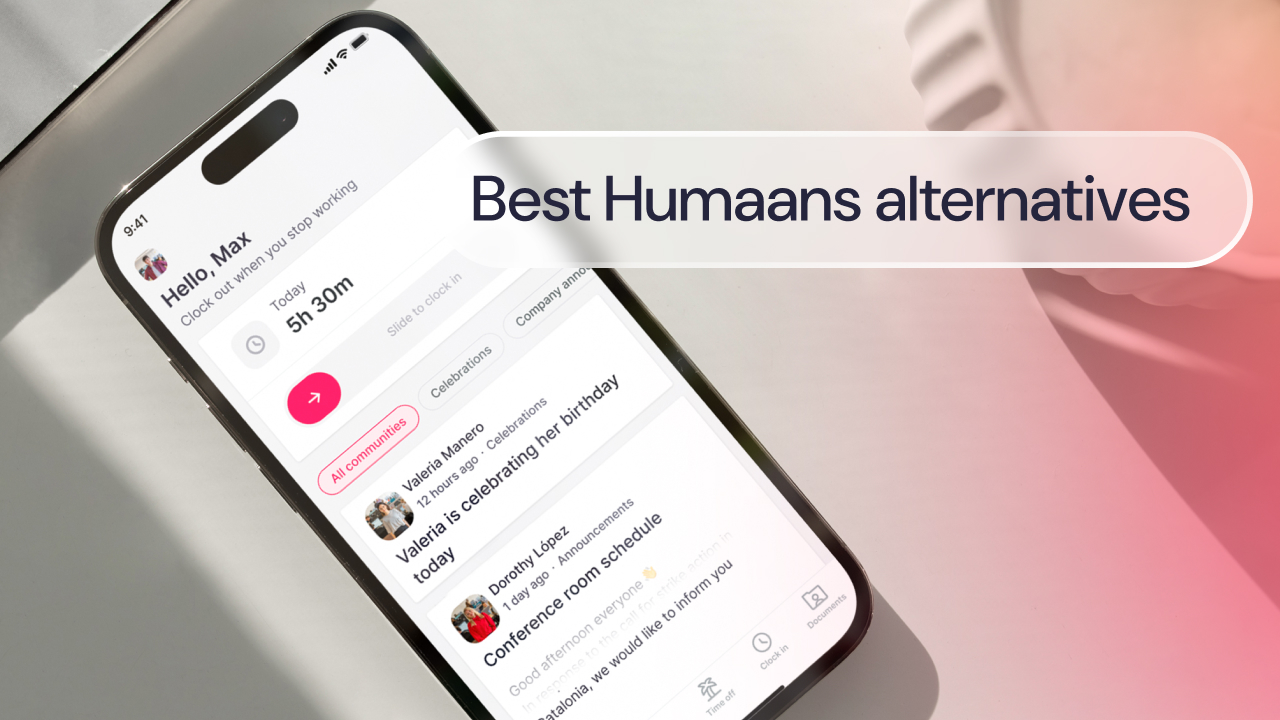It’s important for employers and employees to be aligned with expectations, responsibilities and professional goals. This requires constant communication and feedback from both parties. However, when an employee takes an extended leave, it’s best to conduct a return to work interview. This return to work meeting sets aside dedicated time for both parties to sync about any concerns. In this article, we’ll explain how to get the most out of your interview. We’ll cover structure, benefits and tips, as well as return to work interview questions.
TABLE OF CONTENTS
- What is a Return to Work Interview?
- Benefits of Return to Work Interviews?
- Return to Work Meeting Tips
- Return to Work Meeting Structure
- Questions to ask during a Return to Work Interview
- Get your free PDF Return to Work Template ✅
What is a Return to Work Interview?
Employers may choose to conduct a return to work interview when an employee returns from a prolonged period of absence, whether that’s an emergency leave or maternity leave. This is simply a meeting held between the two parties before, or on the day of, the employees’ return.
As back to work interviews are not a legal requirement, many companies choose not to conduct them. However, integrating them into your absence management policy can be hugely beneficial to you as an employer. They are an opportunity to pinpoint and address any employee concerns and or changes to their requirements. Based on this, you can form a personalised action plan to reduce future absences.
Return to Work Interview Benefits
Many employers may avoid return to work interviews due to resource and time constraints. It may seem like just another thing to add to managers’ workloads. But, the ends justify the means. Benefits include:
- Track absences and identify patterns. By spotting any common absence triggers, you might be able to nip them in the bud and prevent future absences.
- Talent retention. When employees feel that their voices are being heard, they are less likely to look for opportunities elsewhere.
- Employee productivity. Again, employees feeling listened to and valued can only lead to positive outcomes!
- Reduce future absences. In the instance of an employee who has taken multiple separate absences for questionable reasons, holding a back to work interview shows you are taking the issue seriously. Clarifying the consequences of this behaviour will likely deter them from repeat offending.
- Improved quality of work. If you identify that they need retraining, you can implement this immediately and increase their productivity.
- Identify necessary adjustments. Adapting to the needs of your returning employee will reduce future absences. More importantly, although the return to work interview is not a legal requirement, employers are legally obliged to make ‘reasonable adjustments’ if the employee is considered ‘disabled’ in line with the Equality Act 2010.
Return to Work Interview General Tips
Before we get into the return to work interview itself, there are a few important points to remember about the set up. In addition to these tips, download our free return to work form to get yourself started.
Create a safe space
Make your employee as comfortable as possible. Welcome them back and show excitement that they’ve returned. This way, it’s more likely they’ll be open and honest. Ensuring you prepare a private space, such as a private room, is integral to this. At the end of the day, you know your employee best. Think about the environment they would be most comfortable in.
Confidentiality
Assure them the personal data you record as part of the back to work interview will be completely confidential and you will adhere to GDPR regulations. You should also highlight the fairness of the process by clarifying that the interview template for all returning employees is standardised as part of your absence management policy.
Show empathy
The purpose of this is not to catch them out. Try to be understanding and really listen to what they’re saying. Absences from work are often related to sensitive topics such as sickness and bereavement.
Ask open questions
Open the floor for them to respond with their own words. Asking open-ended questions allow for breadth in their answers. The more they open up and expand on their thoughts, the better your return to work action plan will be.
Be flexible.
Show that you’re willing to go the extra mile to make them comfortable at work and reduce the need for future absences. That way, the pressure isn’t all on them.
Keep a record
This will be helpful if any issues arise in the future or the absence management policy is breached. You may need to refer back to what was agreed. Our free return to work interview template (link above) is a good place to start.
Keep a neutral stance
Whatever your personal relationship is like with the employee, the content should be relatively official even if the tone is friendly.
Return to Work Interview Structure
A clear structure is important to guarantee you get the most out of your discussion. This should be outlined in your absence management policy to promote consistency and therefore equality across your workforce. A back to work interview will follow this pattern:
- Welcome the employee back to work. Consider making this more meaningful by referencing their reason for absence, whether it be maternity leave, sickness or a bereavement, for example.
- Share any updates. Has anyone left or joined the company? Are there any key structural changes? Have there been shifts that impact their role?
- Assess whether they need retraining. If the absence period was substantial, perhaps they’ll need to be retrained on certain applications or workplace processes.
- Ask about the reason for absence and any adjustments they require. This part of the return to work interview will differ person to person. For example, if their absence was due to maternity leave, they may require flexible work arrangements to allow for childcare. Perhaps this means a phased return to work or a hybrid working schedule. On the other hand, if their absence was related to their health, they might need support in the workplace. They might want to share recommendations from a medical professional. Or, perhaps they are disable and will require ‘reasonable adjustments’ to be made such as physical changes to the workplace or a different shift times. Acas provides more specific advice on how to handle an employee returning to work from sick leave.
- Check whether their absence was related to work. There may be personal triggers in the workplace that you can remove moving forwards.
- Create and agree to an action plan. Both you and the employee should come away from the return to work interview with a clear understanding of any actions that will be taken.
- Clarify your absence management policy and the consequences of breaching it. Explain the process that is triggered when the policy is not adhered to. Do they receive a verbal warning? What happens to repeat offenders?
- Open the floor. Give the employee an opportunity to mention anything that hasn’t been covered. This will fill in any gaps and increase your understanding of how to best prevent absences in the future.
Return to Work Interview Questions
Remember, you know your employees best. Depending on the reason for absence, consider whether any of these might be triggering before asking. Our free return to work interview template (link above) includes these alongside an employer checklist.
- What was the reason(s) for your absence?
- Was your absence related to work?
- Do you have any recommendations from a medical professional about your return to work?
- Is the reason for your absence likely to occur again? Is there anything we can do to prevent recurrence?
- Do you feel ready to return to work? If not, how would you like to proceed?
- Do you need us to make any adjustments to support you as you return? Perhaps either to your work schedule, to the physical workplace or to your role and day-to-day tasks?
- Do you require retraining on any company systems or processes?
If you’re a bit unsure, our free return to work interview template (available below) provides return to work interview questions and tips.
Download Factorial's Return to Work Interview Template
Factorial understands you’re busy, take the guess work out of creating a return to work outline and download a ready-made template. This way, you’ll speed up the process getting your employees’ up-to-date. It’s also a great way to manage your team, build office morale, and improve productivity. With our template, you’ll receive:
- General information
- Questions to ask during your return to work meeting
- Checklist to prepare for your meeting
Managing these meetings should be productive, not a hassle. Make that possible by downloading your free template today! ✅



